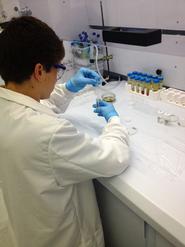
John DeGuardi ’16 is a chemistry major but spent two months this summer working out the age of Woody Island Siltstone, an unusual black shale found in Tasmania, Australia.
DeGuardi and geoarchaeology major Adrien Hilmy ’13 were awarded a Dickson-Rodgers summer research stipend and went to the University of Houston, where they worked in Professor Alan Brandon’s high tech laboratory.
The samples DeGuardi and Hilmy worked on were provided by Eugene Domack, the Joel W. Johnson Family Professor of Environmental Studies, who conceived the project in collaboration with Professor Brandon.
Black shales are the most common type of sediment rock. They host deposits of natural gas and fossils, archiving the paleo climate history of the earth. The rocks are difficult to date without the presence of volcanic ashes or diverse fossil assemblages.
A recently deveolped technique to provide absolute ages for black organic rich shales was employed to study the Australian mudrocks. The method uses two pairs of parent-daughter isotopes – in this case isotopes of the rare elements rhenium (Re) and osmium (Os), found only in parts per billion in most rocks. By reducing the shale’s acids and concentrating the Re and Os, the ratio of the isotopes can be used to provide an age.
The ratios were measured in the University of Houston’s sophisticated spectrometer called a thermal ion ratio mass spectrometer (TIMS). The TIMS measures negative ion isotopes rather than the positive ion isotopes measured by Hamilton’s equipment.
Results so far suggest the age of the shale to be 298 million years +/- 6 million. This is the first absolute age for the Woody Island Siltstone and one presented and published, is expected to be widely cited in the literature.
DeGuardi is a graduate of Ballston Spa High School in Ballston Spa, N.Y.
Posted August 23, 2013
